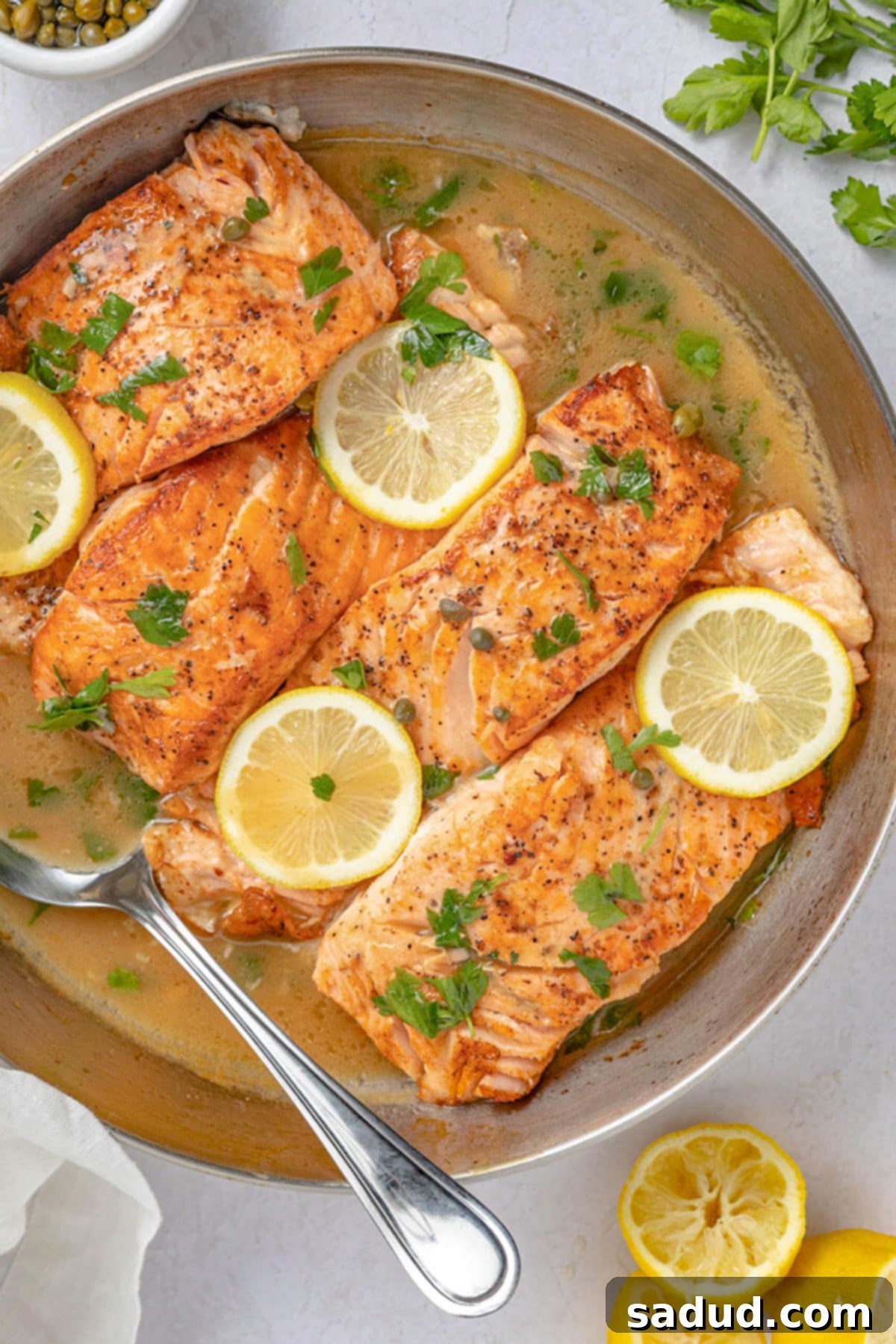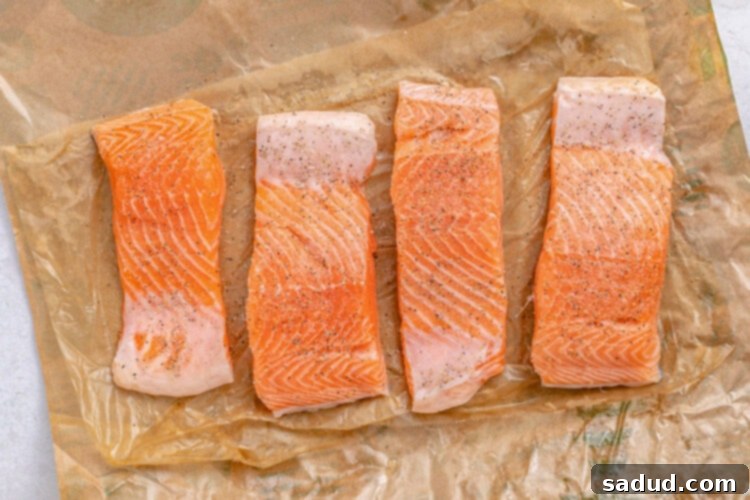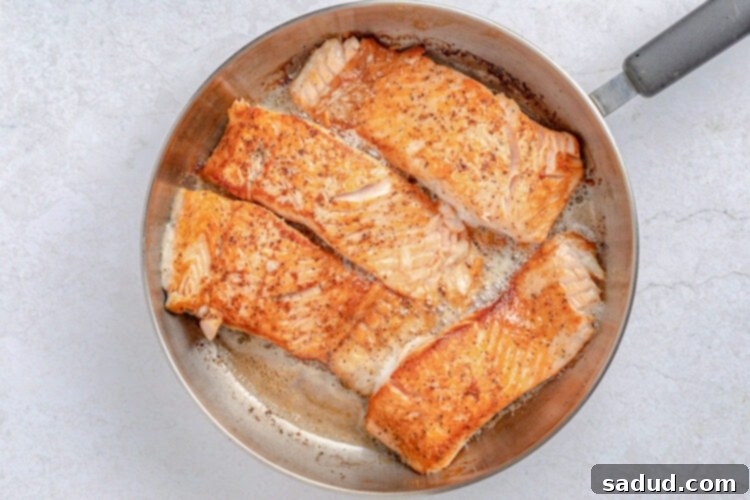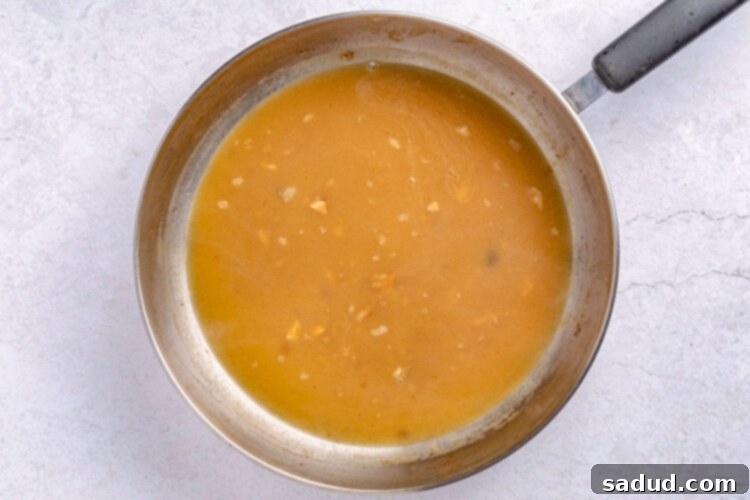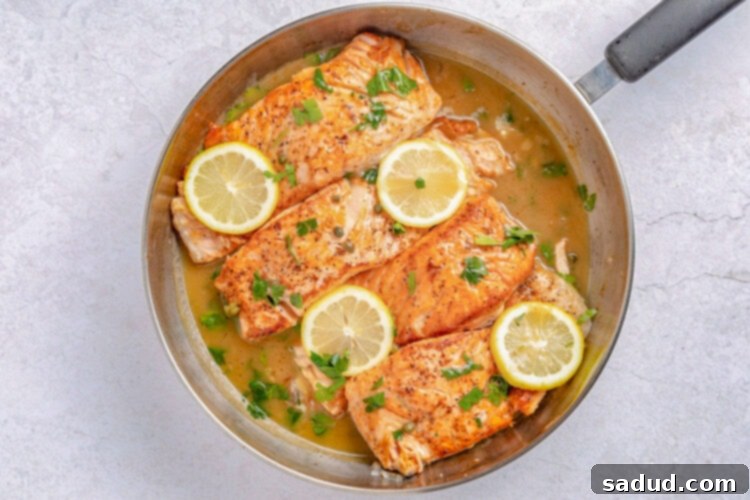Easy Pan-Seared Salmon Piccata: Flaky, Buttery, and Flavorful in 30 Minutes
Prepare to tantalize your taste buds with this incredible Pan-Seared Salmon Piccata recipe! Imagine perfectly cooked, flaky salmon fillets enveloped in a bright, zesty lemon-butter caper sauce. This dish is the epitome of quick elegance, effortlessly transforming from a simple weeknight meal into an impressive centerpiece for special celebrations or entertaining guests. With its rich flavors and appealing presentation, this lemon-buttery salmon is guaranteed to impress even the most discerning palates.
Salmon Piccata offers a sophisticated dining experience without requiring hours in the kitchen. In under 30 minutes, you can achieve a gourmet meal that’s both comforting and vibrant. The secret lies in the pan-searing technique, which creates a delightfully crispy crust on the salmon, locking in its natural juices and adding an extra layer of texture. This simple yet effective cooking method also infuses the pan with savory fond, forming the perfect base for our luscious lemon-butter sauce. The entire process, from searing to saucing, often happens in a single pan, making cleanup a breeze – a true win for any busy cook!
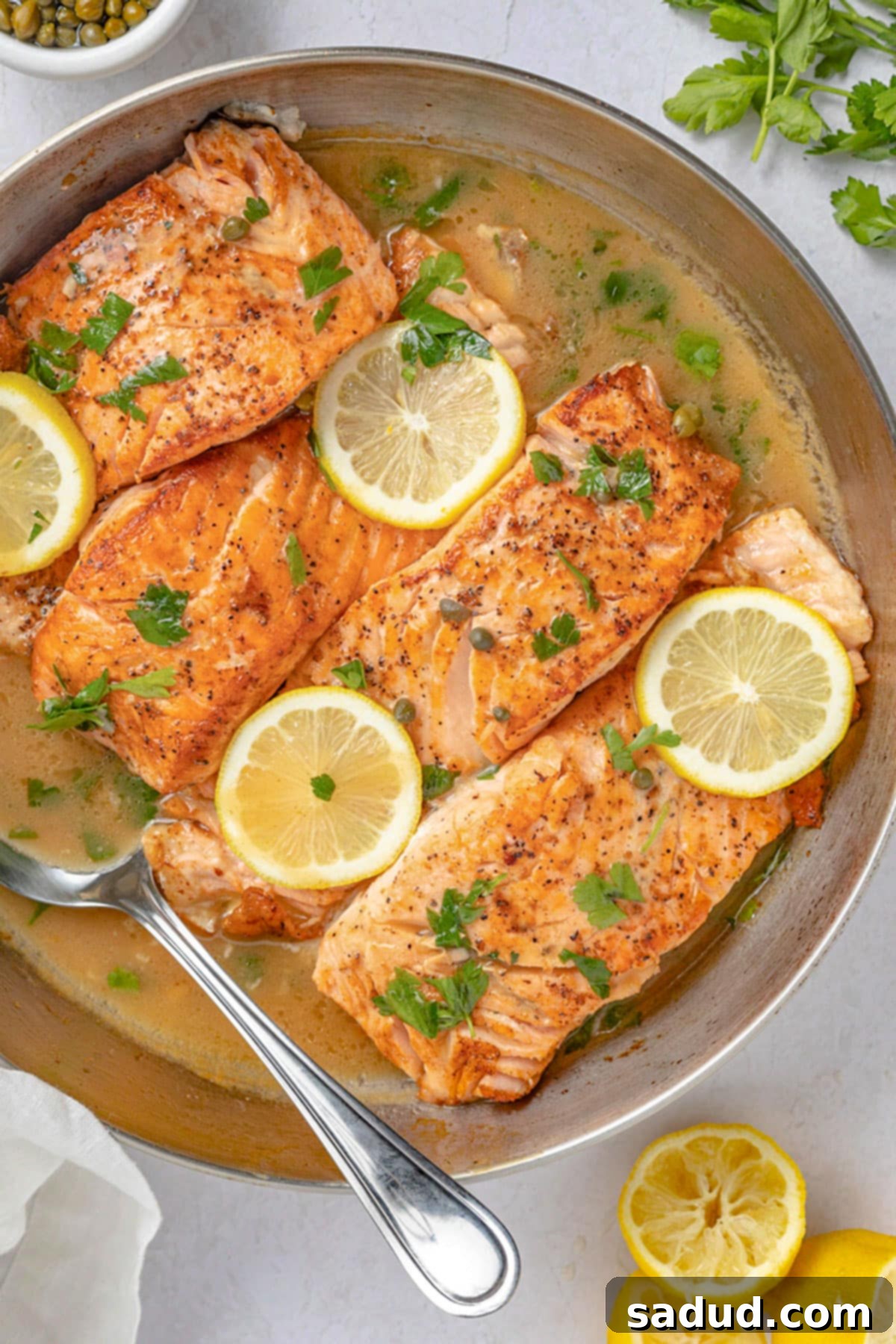
Why This Salmon Piccata Recipe is a Must-Try
There are countless reasons why this salmon piccata will quickly become a cherished recipe in your culinary repertoire. It’s a harmonious blend of speed, flavor, and nutritional value, making it an ideal choice for any occasion.
-
Unbeatable Flavor and Speedy Preparation
This salmon piccata is an explosion of flavor, yet incredibly quick to prepare. The pan-searing process is key, as it not only cooks the salmon to perfection with a delightful crispy skin but also creates a foundation of rich flavor in the pan. This flavorful fond then becomes the base for our vibrant lemon-butter caper sauce, ensuring every bite is infused with depth. The entire meal is ready in under 30 minutes, making it an ideal solution for those busy weeknights when you crave something delicious without the fuss. Despite its speed, the dish feels elevated enough to serve at dinner parties or for special occasions, proving that fast food doesn’t have to mean compromising on quality or elegance. This meal is truly designed to be loved by everyone!
-
A Nutritional Powerhouse
Salmon is celebrated as a fantastic source of high-quality protein, essential for muscle repair, growth, and overall body function. Beyond protein, it’s packed with an array of healthy nutrients, most notably omega-3 fatty acids. These essential fatty acids are crucial for brain health, heart health, reducing inflammation, and even supporting healthy skin and hair. Incorporating salmon into your diet regularly can contribute significantly to your well-being. This salmon piccata offers a delicious and satisfying way to enjoy these vital nutrients, turning a simple meal into a wholesome and health-boosting experience. It’s a win-win: incredible taste and robust nutrition all in one dish.
-
Versatile Pairing Options for Every Palate
One of the best qualities of salmon piccata is its incredible versatility when it comes to side dishes. Its bright, tangy, and savory profile complements a wide range of accompaniments, allowing you to tailor your meal to your preferences or what you have on hand. Classic choices like fluffy rice or tender pasta perfectly absorb the delicious lemon-butter sauce, creating a truly satisfying combination. For those looking to increase their vegetable intake, fresh greens such as steamed or roasted asparagus, or vibrant broccoli (perhaps even sous vide broccoli for an extra touch of gourmet) pair beautifully, adding freshness and a delightful crunch. If you’re catering to picky eaters or simply crave comforting classics, creamy mashed potatoes or roasted potatoes are always a hit. The possibilities for customization are truly endless, ensuring that this dish can be enjoyed by everyone at the table.
Expert Tips for Perfect Salmon Piccata Every Time
Achieving restaurant-quality salmon piccata at home is easier than you think, especially with a few chef-approved tips up your sleeve. These insights will help you elevate your dish and ensure perfect results, whether you’re a seasoned cook or just starting out.
-
Elevate Your Sauce with Dry White Wine
For a truly next-level salmon piccata, consider replacing the chicken broth and a portion of the lemon juice with dry white wine. Varieties like Sauvignon Blanc, Pinot Grigio, or even a dry Chardonnay (unoaked) work wonderfully. The wine introduces a remarkable depth of flavor and complexity that can’t be achieved with broth alone. It adds a subtle acidity and aromatic richness, complementing the lemon and butter beautifully without overpowering the delicate salmon. When cooking, the alcohol evaporates, leaving behind only the exquisite flavor notes. This simple substitution instantly transforms your dish into something more sophisticated and nuanced.
-
Smart Storage and Reheating for Delicious Leftovers
Leftover salmon piccata is a true treat, and it can be easily reheated while maintaining its deliciousness. To store, transfer the salmon and a generous amount of its rich lemon-butter sauce into an airtight container. This is crucial for retaining moisture and flavor. It will stay fresh in the refrigerator for up to 3 days. When it’s time to reheat, the key is “low and slow” to prevent the salmon from drying out. You can gently warm it in a small saucepan over low heat on the stovetop, stirring the sauce occasionally. Alternatively, place the salmon on a baking sheet and heat in an oven preheated to 275° Fahrenheit (135°C) until warmed through. The internal temperature of the salmon should reach between 125℉ to 130℉ (52℃ to 54℃) for optimal texture and flavor.
-
Fresh vs. Frozen: How to Handle Your Salmon
While fresh salmon is always preferred for its superior texture and flavor, high-quality frozen salmon can certainly work in a pinch. The most important step when using frozen fillets is to allow them to thaw completely before cooking. You can do this by transferring them to the refrigerator overnight, or for a quicker method, place the sealed salmon in a bowl of cold water for 1-2 hours, changing the water every 30 minutes. Once thawed, it’s absolutely crucial to pat the salmon dry thoroughly with paper towels. Removing excess moisture promotes a beautiful, crispy sear and prevents the salmon from steaming in the pan, which would result in a less desirable texture. A dry surface ensures that golden-brown crust we all love.
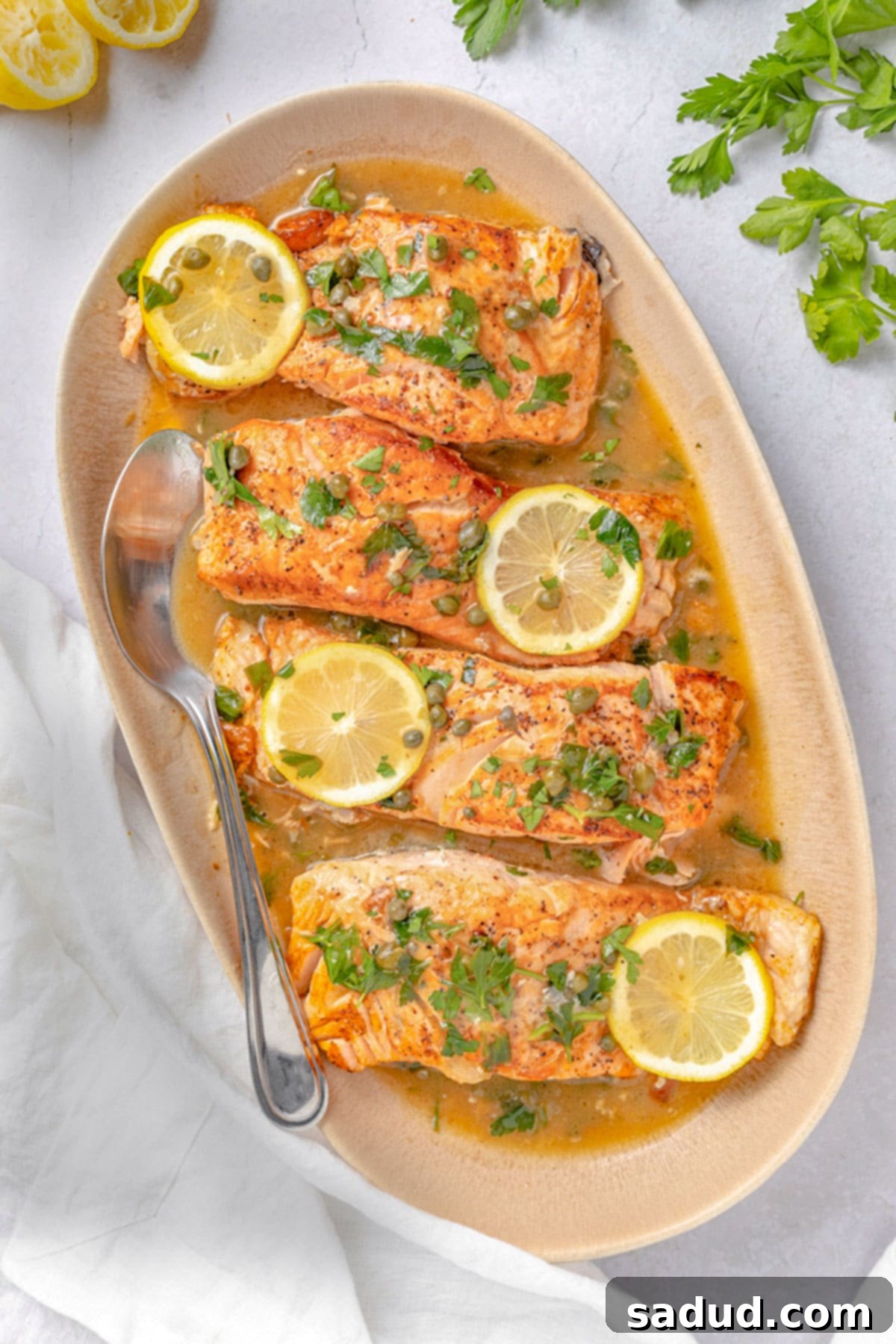
More Delicious Seafood Dinners to Explore
If you’re a fan of seafood and looking for more inspiration, these recipes offer a diverse range of flavors and cooking styles. From classic Italian-American dishes to comforting baked options, there’s something here for every seafood lover.
- Shrimp Francese
- Seafood Baked Potato
- Air Fryer Tuna Steak
- Shrimp Carbonara
- Seafood Jambalaya
- Cajun Shrimp Bisque
- Lobster Mac and Cheese
If you loved this recipe as much as we did, don’t forget to leave us a review below. ★ Follow Easy Healthy Recipes on Pinterest, Facebook, and Instagram, too!
For more delicious recipes, visit our sister sites, 40 Aprons and Easy Cheap Recipes.

Salmon Piccata
 Cheryl Malik
Cheryl Malik
Print
SaveSaved!
Ingredients
- 4 8-ounce salmon fillets
- 1 teaspoon salt more or less to taste
- ½ teaspoon freshly cracked black pepper more or less to taste
- 4 tablespoons butter divided
- ¼ cup fresh lemon juice juice from approximately 2 medium lemons
- ½ cup low-sodium chicken broth
- 1 teaspoon cornstarch
- 3 tablespoons capers drained
- ¼ cup chopped fresh parsley plus more to garnish
- thinly sliced lemon coins optional, to garnish
Equipment
-
Cutting board
-
Paper towels
-
Large skillet
-
Tongs
-
large plate
-
Small mixing bowl
-
whisk
Instructions
-
Begin by preparing your salmon. Place each salmon fillet on a clean cutting board. Using paper towels, pat each side of the salmon completely dry. This step is crucial for achieving a crispy skin. Once dry, season all sides of the salmon generously and evenly with salt and freshly cracked black pepper. Set the seasoned salmon aside while you prepare your skillet.

-
Place a large skillet over medium-high heat on your stovetop. Allow the pan to warm up for a couple of minutes. Once warm, add 2 tablespoons of butter to the skillet. Let the butter melt completely, gently swirling the pan occasionally to ensure the butter is evenly distributed across the entire cooking surface.
-
As soon as the butter is fully melted and shimmering (but not browned or bubbling), carefully place the seasoned salmon fillets into the hot skillet, skin-side down if applicable. Sear the salmon for approximately 3 minutes, or until a beautiful golden-brown and crispy crust has formed on the underside. Using tongs, carefully flip each salmon fillet over and sear the other side for another 3 minutes, or until it, too, is golden brown and cooked through to your desired doneness.

-
Once the salmon is perfectly seared, carefully transfer it from the skillet to a large plate and set it aside. Return the same skillet to the heat, reducing the burner to medium. Add the remaining 2 tablespoons of butter to the pan.
-
While the butter is melting in the skillet, combine the fresh lemon juice, low-sodium chicken broth, and cornstarch in a small mixing bowl. Whisk these ingredients vigorously until they are fully combined and the cornstarch has dissolved. Pour this well-mixed liquid into the skillet with the melted butter.

-
Allow the sauce mixture to gently simmer over medium heat, stirring occasionally, for 3 to 5 minutes. Continue cooking until the sauce has thickened to a consistency that coats the back of a spoon.
-
Remove the skillet from the heat. Add the drained capers and the freshly chopped parsley to the sauce, stirring gently until they are just incorporated. Return the cooked salmon fillets to the skillet. Gently flip the salmon 2 to 3 times to ensure each piece is thoroughly coated in the rich, flavorful piccata sauce.
-
Carefully transfer the sauced salmon fillets to individual serving plates. Drizzle each fillet with any remaining glorious lemon-butter caper sauce from the skillet. If desired, garnish with a few thinly sliced lemon coins and an extra sprinkle of fresh parsley for a touch of color and aroma. Serve this exquisite salmon piccata immediately with your chosen side dishes for a truly satisfying meal.

Notes
- Salmon Selection: If you’re starting with a larger whole salmon fillet, we recommend selecting a 2-3 pound fillet to yield approximately 4 generous servings. Before you begin the recipe, carefully slice the fillet into 4 equal, 8-ounce portions to ensure even cooking and easier handling.
- Broth & Lemon Juice Alternative: For an enhanced depth of flavor, you can substitute the chicken broth and lemon juice with ¾ cup of dry white wine. Excellent choices for this dish include Sauvignon Blanc or Pinot Grigio, as their crisp acidity and subtle fruit notes complement the salmon beautifully.
- Cornstarch Substitute: If cornstarch isn’t available or if you have dietary restrictions, arrowroot starch can be used as a 1:1 replacement to thicken the piccata sauce effectively.
- Make it Dairy Free: To adapt this recipe for a dairy-free diet, simply use your favorite high-quality dairy-free butter alternative in place of regular butter. Most brands perform exceptionally well in pan-searing and sauce-making.
- Storing Leftovers: Ensure the cooked salmon piccata is stored in an airtight container with a generous amount of the lemon-butter caper sauce. The sauce helps to keep the salmon moist and flavorful during storage. When stored correctly, leftover salmon piccata will remain delicious for up to 3 days in the refrigerator.
Nutrition Information
Number of total servings shown is approximate. Actual number of servings will depend on your preferred portion sizes.
Nutritional values shown are general guidelines and reflect information for 1 serving using the ingredients listed, not including any optional ingredients. Actual macros may vary slightly depending on specific brands and types of ingredients used.
To determine the weight of one serving, prepare the recipe as instructed. Weigh the finished recipe, then divide the weight of the finished recipe (not including the weight of the container the food is in) by the desired number of servings. Result will be the weight of one serving.
